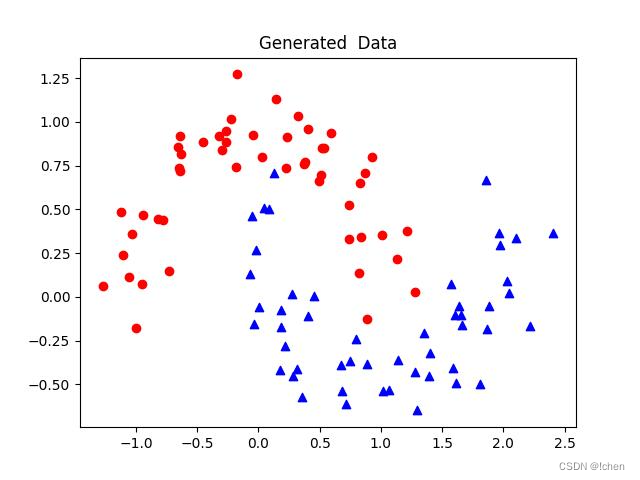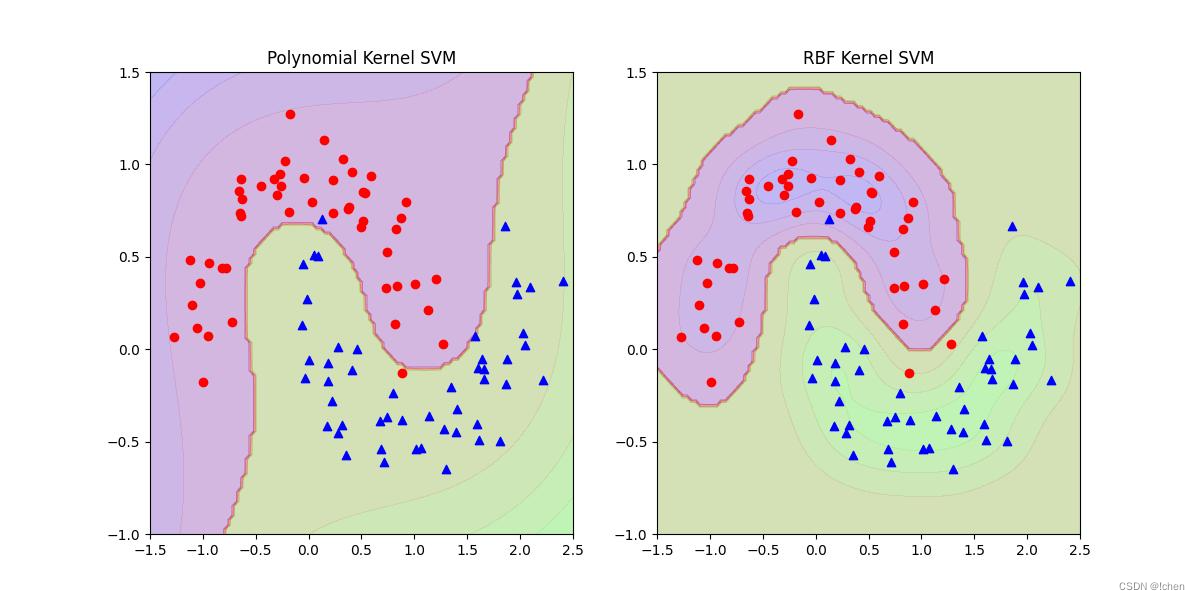多项式核和高斯核进行SVM分类
发布时间:2023年12月25日
from sklearn.datasets import make_moons
import matplotlib.pyplot as plt
X, y = make_moons(n_samples=100, noise=0.15, random_state=42)
plt.scatter(X[y == 0][:, 0], X[y == 0][:, 1], color='red', marker='o')
plt.scatter(X[y == 1][:, 0], X[y == 1][:, 1], color='blue', marker='^')
plt.title("Generated Data")
plt.show()?显示如下图

使用多项式核和高斯核进行SVM分类
from sklearn.svm import SVC
from sklearn.pipeline import Pipeline
from sklearn.preprocessing import StandardScaler
# 多项式核
poly_kernel_svm = Pipeline([
("scaler", StandardScaler()),
("svm", SVC(kernel="poly", degree=3, coef0=1, C=5))
])
poly_kernel_svm.fit(X, y)
# 高斯核(径向基函数)
rbf_kernel_svm = Pipeline([
("scaler", StandardScaler()),
("svm", SVC(kernel="rbf", gamma=5, C=0.001))
])
rbf_kernel_svm.fit(X, y)可视化结果
?为了可视化决策边界和决策函数,我们需要创建一个辅助函数:
?
import numpy as np
def plot_predictions(clf, axes):
x0s = np.linspace(axes[0], axes[1], 100)
x1s = np.linspace(axes[2], axes[3], 100)
x0, x1 = np.meshgrid(x0s, x1s)
X = np.c_[x0.ravel(), x1.ravel()]
y_pred = clf.predict(X).reshape(x0.shape)
y_decision = clf.decision_function(X).reshape(x0.shape)
plt.contourf(x0, x1, y_pred, cmap=plt.cm.brg, alpha=0.2)
plt.contourf(x0, x1, y_decision, cmap=plt.cm.brg, alpha=0.1)
plt.figure(figsize=(12, 6))
plt.subplot(121)
plot_predictions(poly_kernel_svm, [-1.5, 2.5, -1, 1.5])
plt.scatter(X[y == 0][:, 0], X[y == 0][:, 1], color='red', marker='o')
plt.scatter(X[y == 1][:, 0], X[y == 1][:, 1], color='blue', marker='^')
plt.title("Polynomial Kernel SVM")
plt.subplot(122)
plot_predictions(rbf_kernel_svm, [-1.5, 2.5, -1, 1.5])
plt.scatter(X[y == 0][:, 0], X[y == 0][:, 1], color='red', marker='o')
plt.scatter(X[y == 1][:, 0], X[y == 1][:, 1], color='blue', marker='^')
plt.title("RBF Kernel SVM")
plt.show()显示结果如下图:?

文章来源:https://blog.csdn.net/xdpcxq/article/details/135197021
本文来自互联网用户投稿,该文观点仅代表作者本人,不代表本站立场。本站仅提供信息存储空间服务,不拥有所有权,不承担相关法律责任。 如若内容造成侵权/违法违规/事实不符,请联系我的编程经验分享网邮箱:chenni525@qq.com进行投诉反馈,一经查实,立即删除!
本文来自互联网用户投稿,该文观点仅代表作者本人,不代表本站立场。本站仅提供信息存储空间服务,不拥有所有权,不承担相关法律责任。 如若内容造成侵权/违法违规/事实不符,请联系我的编程经验分享网邮箱:chenni525@qq.com进行投诉反馈,一经查实,立即删除!
最新文章
- Python教程
- 深入理解 MySQL 中的 HAVING 关键字和聚合函数
- Qt之QChar编码(1)
- MyBatis入门基础篇
- 用Python脚本实现FFmpeg批量转换
- iptables防火墙(二)
- build.gradle标签详解
- TypeScript 从入门到进阶之基础篇(八)函数篇
- Peter算法小课堂—浮点数危机
- C语言——字符串常量初始化
- python统计学-两个总体均值差的区间估计
- 015:JS之正则表达式,web乱码和路径问题总结,MVC架构模式
- java实现广度优先搜索算法
- vmware安装银河麒麟V10高级服务器操作系统
- Android Media3 ExoPlayer 如何正确设置缓存大小